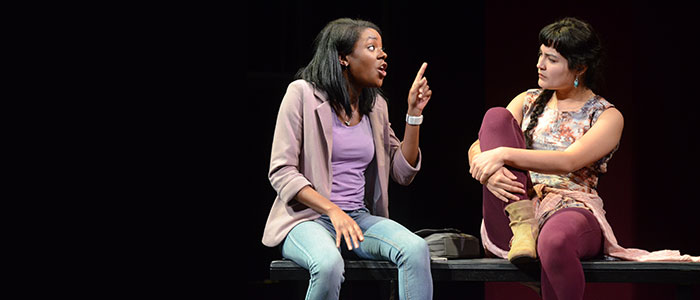Baltimore: Change 101 Now Enrolling
This blog post is by Chelsey McLaughlin, a senior theatre major.

Baltimore photo by Stan Barouh
Over buoyant chatter and high-spirited greetings, a pleasant, professional voice rings out over the intercom system welcoming the incoming Sudbury University freshman class to orientation. Dressed in brightly-hued knit sweaters, Capri pants and copious amounts of denim, the prospective freshmen sit in boisterous apprehension for their newest adventure: attending college. Not long after moving into the dorms, tensions rise as a racially offensive illustration posted on the dorm room door of a black student by a white student causes an uproar in this new cluster of pupils. Deriving inspiration from the poem Incident by Countee Cullen, which recounts an early instance of racism the persona experienced during a visit to Baltimore in his youth, the UMD School of Theatre, Dance, and Performance Studies’ production of Baltimore offers several well-rounded perspectives of eight young adults as they navigate language, community, friendship, race and self.
The genius of Baltimore […] is its approach to tackling social inequalities.
The genius of Baltimore, a Big Ten Consortium play by playwright Kirsten Greenidge, is its approach to tackling social inequalities. The aim is not to blame individuals for their racial insensitivity, but rather to enlighten them of the harm caused by perpetuating racial discrimination and prejudice. The characters of Baltimore propose that all individuals view race through the lens of recognizing differences in social justice and using those findings to work toward an empowered frame of mind that provides for the needs of all individuals.
The use of technical elements in this production are commanding as they underscore the demanding themes of the play. Hand drawn illustrations projected behind the characters on large screens—strategically placed throughout the expansive wooden structure — provide an inner dialogue for the characters and keep the audience emotionally invested in each character’s journey. The multi-level, free-standing, wooden-framed building which serves as a projection surface, is reminiscent of a large old fashion dollhouse which allows the audience to watch several characters simultaneously, even when they are not actively engaged in the scene at hand. Sound aids in the transition from one scene to another: ambient chatter represents a dining hall and chirping crickets identify the grassy school courtyard. The use of bright, white overhead lighting predominates throughout the piece and symbolically represents the glaring surface of American society that willfully chooses to ignore the grim under layers of American society that are still unsettled by racism.
The use of bright, white overhead lighting […] symbolically represents the glaring surface of American society that willfully chooses to ignore the grim under layers of American society that are still unsettled by racism.
Baltimore also uses strong female characters to interpret the continued struggle of many minority groups who try to live their lives under the pressure of minds warped by systemic racism and Eurocentric standards of beauty, success and behavior. But the ending is a hopeful one as these young adults, the future minds of America, are audacious enough to tackle issues that existed long before they did. It is a testament to their ambition, strength and will to succeed.
